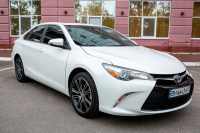The 2016 Toyota Camry sedan retained the exterior and interior finishes of the previous model year vehicles. The vehicle was equipped with gasoline engines and a unified transmission with automatic gearshift. The restyling carried out in 2015 allowed to refresh the appearance of the car and keep the interest of potential buyers.
Toyota Camry 2016 exterior
After the 2015 restyling, the car received an updated design, which combined a conservative style and sporty notes. Due to the use of a massive front bumper and narrow lighting equipment, the silhouette of the car became more recognizable in the traffic flow. 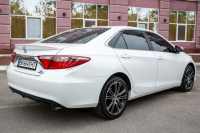 The glazing retained its greenish insulating coating, and the structure of the windshield has an additional layer, which improved acoustic comfort.
The glazing retained its greenish insulating coating, and the structure of the windshield has an additional layer, which improved acoustic comfort.
Body
All-metal body with 4 hinged doors has plastic bumpers to withstand collisions with stationary objects at speeds up to 5 km/h.
Headlights with lenses and incandescent or discharge lamps provided improved illumination of the road (the manufacturer refused to introduce LED optics).
At the rear there are still narrow headlights, connected by a narrow chrome plate installed on the lid of the luggage compartment.
Car interior  The interior of the cabin has not changed compared to the 2015 model year. Soft plastic was used for the upper part of the dashboard and door cards to reduce the noise level.
The interior of the cabin has not changed compared to the 2015 model year. Soft plastic was used for the upper part of the dashboard and door cards to reduce the noise level.
In front of the driver appeared the instrument cluster with the information screen of the bot computer.
Entune multimedia system
Some Camry models had a radio that could be controlled remotely by a utility program installed on a smartphone.
Entune lets you start and stop the engine when the driver is not in the car, control door locks, display information about open items on the phone screen (if there are sensors under the panels), check the remaining fuel in the tank or search for the car in the parking lot.
Technical Specifications
Technical parameters of the car remained unchanged compared to the previous year.
The manufacturer used only gasoline engines with electronically controlled fuel supply and catalytic converters (emission standards meet the requirements of Euro-5).
Dimensions
Body dimensions:
length - 4,820 mm (U.S. models have a length of 4,850 mm);
Width (along the door sides) - 1820 mm;
height - 1470 mm;
basis - 2775 mm;
front/rear track - 1575/1565 mm;
ground clearance - 160 mm.
Weight parameters
Weight parameters of the vehicle:
curb weight (without people in the cabin) - from 1505 (model with 2.0-liter engine) to 1615 kg (version with V-6 engine);
GVW - not more than 2100 kg;
payload - up to 485 kg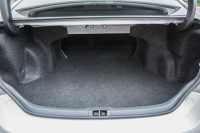 Engine
Engine 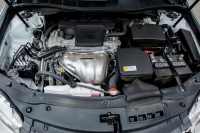 The factory used three types of engines:
The factory used three types of engines:
2-liter 1AZ-FE with 150 hp;
2.5 liter 181 hp 2AR-FE;
V-shaped 2GR-FE with a capacity of 3.5 liters and 249 hp.
Transmission and steering
The transmission was an Aisin six-speed hydromechanical gearbox with manual shift function. Rack and pinion steering was equipped with an electric booster (with progressive change of amplification coefficient).
Suspension and brakes
Suspension characteristics:
front suspension - independent with lower arm, McPherson struts and anti-roll bar;
rear suspension is independent with 3 arms, coil spring shock absorber and anti-roll bar;
brakes are disc type (ventilated in front) with floating brackets, vacuum booster and hydraulically actuated from the pedal.
Rims and tires
The rims are aluminum alloy, and the tires are 205/60R16 or 215/55R17 (depending on equipment level).
The manufacturer stowed in the luggage compartment a full-size spare tire with alloy wheels.
Performance data
Key performance indicators:
maximum speed - up to 210 km/h;
tank volume - 70 liters;
Fuel consumption in the combined cycle - from 7.2 liters (for the engine capacity of 2.0 liters) to 9.3 liters (for a 3.5-liter unit) per 100 kilometers of run;
Acceleration time from a place up to 100 km/h - 7.1/9/10.4 seconds (for engines with 2.0/2.5/3.5 liters, respectively).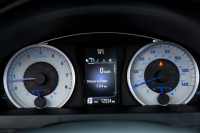 Safety systems
Safety systems
The car has a body with a power frame made of high-strength alloy steel, which provides preservation of the volume of the passenger compartment in case of a front or side impact.
There are programmable deformation zones in the front and rear. In the event of a collision, the engine retreats downwards, preventing the engine shield from collapsing.
Driver and front passenger seats were equipped with seat belts with upper attachment point adjustment and pyrotechnic pretensioners. The rear sofa received 3 inertia belts.
Front and side airbags and curtain airbags were installed by default (the Luxe version used side airbags in the back of the rear row of seats and a knee airbag in the dashboard).
The ABS unit supported BAS emergency braking and Electronic Force Distribution. There were systems of driving wheel slip prevention and trajectory stabilization.
There were front seats made with WIL technology, reducing the risk of injury to the cervical spine in the event of a rear-end collision.
Advantages and disadvantages
Advantages of cars noted in the reviews:
increased reliability;
large volume of the luggage compartment;
comfortable driver's seat with adjustable lumbar support.
Disadvantages of the vehicles:
Weak paintwork and uneven body zinc plating;
possible rust spots under the trunk lid seal;
high level of aerodynamic noise after 120 km/h (the defect is partially fixed by additional insulation);
mediocre handling at high speed.
